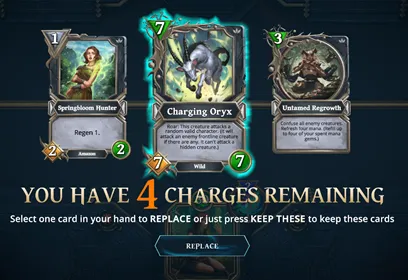TLDR: Quite a lot of reading here, if you don't have time just skip to the last part where there are the probabilities of getting the desired card(s) — whichever it is — during the mulligan... Still, I find some of the numbers below quite interesting, and certainly helpful for deck building strategies
Intro
What is a mulligan and how it works?

After choosing a god power, the player is offered 3 cards as a starting hand with an option to replace one of the cards. The player who starts the first round has 3 opportunities to replace any one of the 3 cards currently in hand, whereas the player who plays second has 4 opportunities. When the card is replaced, it is guaranteed this card will not appear again during the mulligan (unless it is already there twice), and that holds even if there are two such same cards in the deck.
Motivation
Can some decks be built to benefit from Mulligan more than others?
Obviously, having a strong opening hand dramatically increases the chances of winning as some cards have better value at the start of the game than others. So, what are the odds, that those cards will be presented to you during the Mulligan? Is it independent of how the deck is structured or not?
Some "Mafs"
Why is it quite hard to compute exact probabilities?
Initially, the plan was to come up with the exact probabilities. For example, what is the probability that you get 1 unique card after mulligan from the deck of 30 unique cards? It is easy, there are 29 x 28 x 27 possibilities you don't get it straight to hand out of all 30 x 29 x 28 possibilities, which is a 0.9 probability that you don't get it in the initial triplet. That corresponds to exactly 1-0.9=0.1 probability (10 % chance) of the opposite — hitting your desired card (like Pyramid Warden). After 3 mulligan changes, the probability goes up to (1-(24/30))=0.2, and after 4 changes, to 0.233. With each drawing (i.e., with the drawing the very first card), the probability increases by approx. 3.3%. In the 9th round, the probability is already 50%.
But... what if you have the desired card (and some other cards) twice in the deck? Here it starts to be a bit more complicated, as it depends on how many of the other cards are there twice and how many are unique. It leaves you to decide the replacing strategy (if you are offered two same unwanted cards, replace the third unwanted or one of these two?). That's where I realized that I am a bad mathematician to compute these combinations precisely, taking into account the card repetitions, 3-step card-drawing, and especially, the removal of duplicates from being offered by changing a card that is twice in the deck (this last part gave me a headache).
Brute Force Experiments
If you suck at math, you still have a chance to be an engineer :-), right?
For each one of the experiments below, I have simulated 1,000,000 random mulligans. The results show the probability of an event (e.g., get 1 desired card) within all the runs. The probabilities include the card that is drawn after the mulligan. So the protocol follows: i) draw 3 cards, ii) do up to 3 (or 4) changes, iii) draw one card. Here comes the essence of this post, so just enjoy the numbers :-).
Getting 1 desired card (first player / second player)
e.g., getting a Pyramid Warden
- 23.4% / 26.7% in the deck of 30 uniques, i.e., the desired card being once there
- 41.8% / 46.9% in the deck of 28 uniques, i.e., the desired card being twice there
- 43.9% / 50.0% in the deck of 15 pairs, i.e., the desired card being twice there
Getting 2 desired cards both (first player / second player)
e.g., getting a Marsh Walker and Shieldbearer
- 3.5% / 4.2% in the deck of 30 uniques, i.e., the desired cards being once there each
- 11.8% / 13.8% in the deck of 26 uniques, i.e., the desired card being twice there each
- 12.2% / 14.5% in the deck of 15 pairs, i.e., the desired cards being twice there each
Getting 1 of 2 desired cards (first player / second player)
e.g., getting a Pyramid Warden or Bronze Gate
- 41.9% / 46.9% in the deck of 30 uniques, i.e., the desired cards being once there each
- 67.8% / 73.3% in the deck of 26 uniques, i.e., the desired card being twice there each
- 70.1% / 76.7% in the deck of 15 pairs, i.e., the desired cards being twice there each
Summary
- If you want a decent chance (as much as 50%) of getting a card for the first round, it's a must to have it twice in the deck. To further increase the odds by small percents, it's good to have decks full of paired cards.
- Building a deck about an early-game synergy of two exact cards is a risky strategy with unsustainable results (1 in 10 games success)
- Having at least two alternative cards for early-game scenario yields a high probability of getting one of them almost every game
- Legendaries have much less chance to be obtained within the mulligan. Building an early game strategy around one legendary card (e.g. Eva, Baroness of the Dead) is unsustainable.
EDITS (v3): Some spelling typos and minor reformulations. Corrected error (30/24) to 24/30 in one of the formulas.